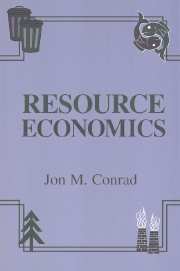Book contents
5 - The Economics of Nonrenewable Resources
Published online by Cambridge University Press: 05 June 2012
Summary
Introduction and Overview
Nonrenewable resources do not exhibit significant growth or renewal over an economic time scale. Examples would include coal, oil, and natural gas and minerals such as copper, tin, iron, silver, and gold. We noted in Chapter 1 that a plant or animal species might be more appropriately viewed as a nonrenewable resource than as a renewable resource. In Chapter 2 we developed a model of a nonrenewable resource to show how Solver might be used to determine the optimal time path of depletion. In Chapter 4 the cutting of old-growth forest was modeled as a nonrenewable resource.
If the initial reserves of a nonrenewable resource are known, the question becomes “How should they be extracted over time?” Is complete depletion (exhaustion) ever optimal? Is it ever optimal to abandon a mine or well with extractable reserves? Does the time path of extraction by a competitive firm differ from that of a price-making monopolist? If exploration allows a firm to find (acquire) more reserves, what are the optimal time paths for extraction and exploration?
In working through the various models of this chapter an economic measure of resource scarcity which is different from standard measures based on physical abundance will emerge. From an economic perspective, scarcity should reflect marginal value net of the marginal costs associated with extraction. The Lagrange multiplier, encountered in our models of renewable resources, will once again provide an appropriate economic measure of scarcity.
- Type
- Chapter
- Information
- Resource Economics , pp. 77 - 100Publisher: Cambridge University PressPrint publication year: 1999



